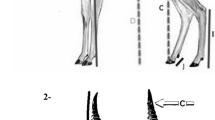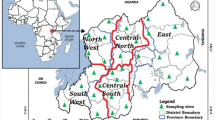Abstract
One hundred and thirty-two tench were photographed and a total of 13 landmarks were identified. Fish were grouped in four size classes on length basis and different shape descriptors were computed. Landmark configurations were superimposed. Size was computed as centroid size. The roundness coefficient, the log(partial area)/log(total area) ratio and the condition coefficient were calculated. Slaughtering performances and fillet composition analyses were performed. Shape variability was found primarily on cephalic area while head and tail regions were more homogeneous. A high correlation between centroid size and total length was found as well as a higher increase of the partial area than the total area justifying the hump shape of this tench. The scatter of relative warp 1 scores and centroid size for the four size classes has showed, with the increase of the length, a larger number of specimens that were characterised by a deep profile. Geometric morphometric approach produced a valuable tool in defining morphospaces for tench. Condition coefficient ranged from 1.24 to 1.29, without any significant difference among the size classes. Slaughtering performance resulted in agreement with those reported by other authors while VSI was lower. In fillets, the fatty acid profile was composed of about 30% of saturated fatty acids, 50% of monounsaturated fatty acids and 20% of polyunsaturated fatty acids with about 8% of docosahexaenoic acid. Atherogenic and thrombogenic indices were 0.58 and 0.42, respectively. Both n6/n3 and polyunsaturated/saturated fatty acids ratios were in accordance with value recommended for a healthy nutrition giving positive evaluation of the nutritional qualities of tench.




Similar content being viewed by others
References
AOAC (2000) Official methods of analysis, 17th edn. Association of Official Analytical Chemists, Gaithersburg
Adam DC, Rohlf FJ, Slice DE (2004) Geometric morphometrics: ten years of progress following the “revolution”. Ital J Zool 71:5–16
Ambrosio PP, Corrado C, Sánchez P, Flos R (2008) Stocking density and its influence on shape of Senegalese sole adults. Aquac Int 16:333–343
Bachasson B (1991) Mise en valeur des étangs. Tec et Doc Lavoisier Ed, Paris
Billard R, Flajšhans M (1995) The current state of research, culture of tench, Tinca tinca Linnaeus (1758). Concluding remarks on the workshop. Pol Arch Hydrobiol 42:219–225
Bookstein FL (1991) Morphometric tools for landmark data. Cambridge University Press, Cambridge
Buchtová H, Smutna M, Vorlova L, Svobodova Z, Flajšhans M (2004) Fatty acid composition of diploid and triploid population of tench (Tinca tinca L.). Acta Vet Brno 73:235–245
Buchtová H, Vorlova L, Svobodova Z, Flajšhans M (2005) Chemical composition of flesh of diploid, triploid population of tench (Tinca tinca, Linnaeus 1758). Czech J Anim Sci 50(5):213–219
Corti M, Thorpe RS, Sola L, Sbordoni V, Cataudella S (1988) Multivariate morphometric in aquaculture: a case study of six stocks of the common carp (Cyprinus carpio) from Italy. Can J Fish Aquat Sci 45:1548–1554
Department of Health (1994) Nutritional aspects of cardiovascular disease (Report on health and social subjects no. 46). H.M. Stationery Office, London
Favarolo E, Mazzola A (2003) Shape change during the growth of sharsnout seabream reared under different conditions in a fish farm of the southern Tyrrhenian Sea. Aquac Eng 29:57–63
Ferreira de Castro FA, Pinheiro Sant’Ana HM, Campos FM, Brunoro Costa NM, Coelho Silva MT, Salaro AL, do Carmo Castro Franceschini S (2007) Fatty acid composition of three freshwater fishes under different storage and cooking processes. Food Chem 103:1080–1090
Folch J, Lees M, Stanley GHS (1957) A simple method for the isolation and purification of total lipids from animal tissues. J Biol Chem 226:494–509
Gai F, Palmegiano GB (2002) Qualità dei pesci di mare e di acqua dolce: valutazione comparata del profilo lipidico. Il Pesce 6:107–113
Gasco L, Zoccarato I, Lussiana C, Azzi L, Julini M (2001) Valorizzazione del territorio attraverso l’allevamento della tinca: il caso del Pianalto di Poirino (Piemonte). Atti 36° S.I.P.ZOO., pp 109–114
Henderson RJ, Tocher DR (1987) The lipid composition and biochemistry of freshwater fish. Prog Lipid Res 26:281–347
Jankowska B, Zakes Z, Zmijewski T, Szczepkowski M, Wunderlich K (2006) The impact of diet on the slaughter yield, proximate composition. and fatty acids profile of fillets of tench (Tinca tinca L.). Arch Pol Fish 14:195–211
Kennedy M, Fitzmaurice P (1970) The biology of tench (Tinca tinca L.) in Irish waters. Inland Fish Trust Dublin Proc RIA 69B:31–83
Le Cren ED (1951) The length-weight relationship and seasonal cycle in gonad weight and condition in perch. J Anim Ecol 20:201–219
Lohnisky K (1966) Bemerkungen zum Wachstum der Schleie (Tinca tinca Linnaeus, 1758). Acta Soc Zool Bohemoslov 30:114–128
Loy A, Ciccotti E, Ferrucci L, Cataudella S (1996) An application of automated feature extraction and geometric morphometrics: temperature-related changes in body form of Cyprinus carpio juveniles. Aquac Eng 15:301–311
Loy A, Mariani L, Bertelletti M, Tunesi L (1998) Visualizing allometry: geometric morphometrics in the study of shape changes in the early stages of the two-banded sea bream, Diplodus vulgaris (Perciformes, Sparidae). J Morphol 237:137–146
Loy A, Bronzi P, Molteni S (1999) Geometric morphometries in the characterisation of the cranial growth pattern of Adriatic sturgeon Acipenser naccarii. J Appl Ichthyol 15:50–53
Loy A, Bertelletti M, Costa C, Ferlin L, Cataudella S (2001) Shape changes and growth trajectories in the early stages of three species of the genus Diplodus (Perciformes, Sparidae). J Morphol 250:24–33
Moreira AB, Visentainer JV, de Souza NE, Matsushita M (2001) Fatty acids profile and cholesterol contents of three brasilian brycon freshwater fishes. J Food Compos Anal 14:565–574
Orban E, Nevigato T, Masci M, Di Lena G, Casini I, Caproni R, Marzetti A, Rampacci M, Maccaroni A (2002) Nutritional qualities of three freshwater fish species from some Italian lakes. Aquaculture Europe 2002 conference, pp 402–403
Ozogul Y, Ozogul F, Alagoz S (2007) Fatty acid profiles and fat contents of commercially important seawater and freshwater fish species of Turkey: a comparative study. Food Chem 103:217–223
Quiros M, Alvarino JMR (1998) Major fatty composition and lipid content in tench (Tinca tinca). A comparison between two different culture systems. Pol Arch Hydrobiol 45:347–351
Rohlf FJ (2004) TpsSuper., ver. 1.14. Departement of Ecology and Evolution, State University of New York and Stony Brook, Stony Brook, NY
Rohlf FJ (2008) TpsRelw., ver 1.46. Departement of Ecology and Evolution, State University of New York and Stony Brook, Stony Brook, NY
Rohlf FJ, Marcus LF (1993) A revolution in morphometrics. Trends Ecol Evol 8:129–132
Rohlf FJ, Slice DE (1990) Extension of the procrustes method for the optimal superimposition of landmarks. TREE 8:129–132
Schäperclaus W (1962) Traité de pisciculture en étang. Vigot Frères Editeurs, Paris
Skora S (1964) Characteristics of tench (Tinca tinca L.) in the reservoir of Goczalkowice. Acta Hydrobiol 6(2):97–118
SPSS (2004) User’s guide, base 13.0 for windows statistical package for Social Sciences Inc. Chicago
Steffens W, Wirth M (2007) Influence of nutrition on the lipid quality of pond fish: common carp (Cyprinus carpio) and tench (Tinca tinca). Aquac Int 15:313–319
Suter PY, Morand C (1975) Analyse du coefficient de condition absolu de trois population de carpes (Cyprinus carpio) et de tanche (Tinca tinca). Laboratoire d’Ecologie appliqué de l’ENSAI, Nancy
Turchini G, Moretti VM, Mentasti T, Orban E, Valfré F (2007) Effects of dietary lipid source on fillet chemical composition, flavour volatile compounds and sensory characteristics in the freshwater fish tench (Tinca tinca L.). Food Chem 102:1144–1155
Ulbricht TLV, Southgate DAT (1991) Coronary hearth disease: seven dietary factors. Lancet 338:985–991
Vácha F, Tvrzická E (1995) Content of polyunsaturated fatty acids and cholesterol in muscle tissue of tench (Tinca tinca), common carp (Cyprinus carpio) and hybrid of bighead carp (Aristichthys nobilis) with silver carp (Hypophthalmichthys molitrix). Pol Arch Hydrobiol 42:151–157
Wang J, Min W, Guan M, Gong L, Ren J, Huang Z, Zheng H, Zhang J, Liu H, Han Y (2006) Tench farming in China: present status and future prospects. Aquac Int 14:203–206
Wedekind H, Rennert B, Kohlmann K (2003) Product quality in different strains of tench tested under controlled environmental conditions. J Appl Ichthyol 19:174–176
Wooton RJ, Evans GW, Mills L (1978) Annual cycle in the female three-spined sticklebacks (Gasterosteus aculeatus) from an upland and a lowland population. J Fish Biol 12:331–343
Zelditch ML, Swiderski DL, Sheets HD, Fink WL (2004) Geometric morphometric for biologists: a primer. Elsevier, Amsterdam
Zoccarato I, Gasco L, Julini M (1998) La produzione tipica della tinca dell’altopiano di Poirino: situazione attuale. Proceedings of the national conference “Parliamo di…qualificazione e tipizzazione dei prodotti di origine animale”, pp 157–160
Acknowledgments
This research was supported by “Università di Torino (ex 60%)” grant (Es. fin. 2006–2008). The authors thank gratefully to Mrs. Cristina Vignolini (Department of Veterinary Morphophysiology—University of Turin) for the help on the image program utilization and Dr. Flavio Ronco for the help on data format management. The collaboration with Pianalto breeders during the realization of the present work is gratefully acknowledged. Many thanks are due to two anonymous referees that have improved this manuscript.
Author information
Authors and Affiliations
Corresponding author
Rights and permissions
About this article
Cite this article
Gasco, L., Gai, F., Lussiana, C. et al. Morphometry, slaughtering performances, chemical and fatty acid composition of the protected designation of origin “Golden hump tench of Poirino highland” product. Rev Fish Biol Fisheries 20, 357–365 (2010). https://doi.org/10.1007/s11160-009-9141-2
Received:
Accepted:
Published:
Issue Date:
DOI: https://doi.org/10.1007/s11160-009-9141-2




